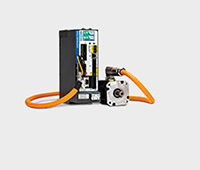Space is an exceptionally harsh environment that demands encoder performance far in excess of normal operational limits. Space-qualified components also need to be inordinately reliable as repair while in orbit is economically unfeasible; thus, the selection of qualified technology is an arduous process.
Renishaw’s space-encoder technology was installed on the advanced Optical Communications Payload (OCP) of the European Space Agency’s Sentinel-1A satellite. The encoder is a part of an inter-satellite laser communication system. The OCP provides an optical Low Earth Orbit (LEO) to Geostationary Earth Orbit (GEO) communications link through a pair of Laser Communication Terminals (LCT) by space telecommunications company Tesat-Spacecom (Tesat). The GEO LCT is currently accommodated on Europe’s AlphaSat.

Unique reference marks allow the encoder to determine absolute position with minimal rotation.
Tesat required a new rotary (angle) encoder for the coarse pointing assembly (CPA) of its second generation LCT, which is essentially a telescope with coherent receiver and transmitter hardware. The space-qualified encoder was developed in collaboration with Tesat and shares much of its core technology with Renishaw’s TONiC encoder range. It is designed to withstand operating temperatures from 40 to 80° C, bombardment by solar and cosmic radiation as well as high mechanical loads consistent with rocket launch. Radiation hardening, combined with Renishaw’s robust optical detection principle, has resulted in the encoder achieving qualification for an impressive 15-year service in a Geostationary Earth Orbit (GEO) environment.

Renishaw and Tesat’s advanced space-encoder is installed on both rotary axes of the CPA and will be integrated into the LCTs of a number of future space platforms, including the Sentinels and the European Data Relay Satellites EDRS-A and EDRS-C. The encoder system consists of a stainless steel ring with ablated graduations on the periphery and a specially adapted readhead. INTRAC reference marks are directly embedded into the incremental channel and arranged so that the distance between any two marks is unique. This means that only a small rotation is required before the absolute position is known. Another advantage is that there is no contact between the rotary ring and static readhead, which eliminates friction and, hence, hysteresis error as well as potential wear or any need for lubrication. The system achieves a resolution of less than 0.5 µrad, with a short-range error of
This development was funded on behalf of the German Aerospace Center (DLR) by the Federal Ministry of Economics and Technology based on legislation by the German Parliament in the framework of project 50YH0932 of TESAT with Renishaw as subcontractor.
Renishaw
renishaw.com
Filed Under: Encoders (rotary) + resolvers, MOTION CONTROL





Tell Us What You Think!